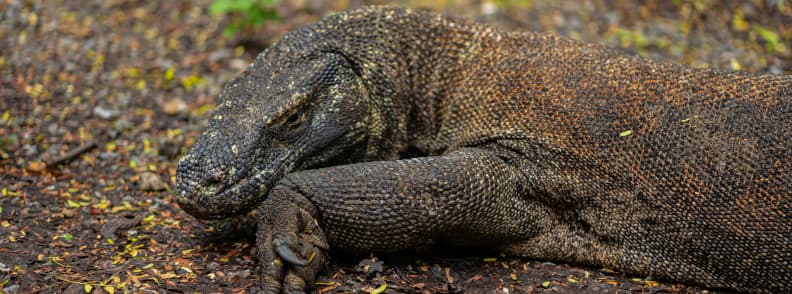It’s one of the most iconic images in Southeast Asia: a Komodo dragon slowly crossing dry savannah beneath a blazing sun, its massive tail sweeping the dust behind it. These ancient reptiles, found nowhere else on Earth, are the stars of Komodo National Park, but they’re far from the only reason travelers come here.
Home to over two dozen islands, vibrant coral reefs, and rugged hiking trails, Komodo is a paradise for adventure seekers and nature lovers.
Visit Komodo Island Guide
However, as tourism numbers grow, the park faces mounting pressure, both ecological and cultural. In response, Indonesia has recently introduced visitor quotas, restricted access to certain islands, and placed more emphasis on sustainability.
So how do you visit Komodo without contributing to overtourism or feeling like you’re following the crowd? Here’s how to do it the right way: respectfully, responsibly, and without losing the magic that brought you here in the first place.
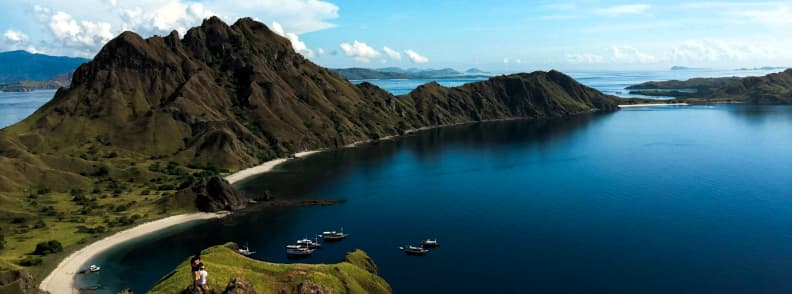
Why “Responsible” Travel Matters More Than Ever
According to recent reports, including Travel and Tour World, Indonesian authorities are placing strict limits on visitors to sensitive areas like Padar Island, an effort to curb the environmental damage caused by mass tourism.
Overcrowding on narrow hiking paths, litter on beaches, and noise pollution from boat engines have all become serious concerns in recent years. At the same time, large-scale development projects, like piers and resort complexes, are threatening both wildlife habitat and Indigenous land rights.
Responsible travel in Komodo isn’t a trendy concept. It’s a necessary shift toward preserving what makes the park special in the first place.
Since 2024, travelers going to Komodo and Padar islands have had to book daily permits online, and these often get snapped up quickly during the busy season. On Rinca, rangers have also started using a new tracking system that helps them see in real time how many visitors are on the trails, so they can step in before the paths and nesting areas become too crowded.
Plan Your Visit Off-Peak And Off-Path
If you’re flexible with timing, plan your trip to Komodo outside of the July-August high season. The weather is still good in shoulder months like April, May, and September, but you’ll avoid the bulk of tourist traffic. Sunrise or late afternoon visits to popular spots (like Padar or Pink Beach) can also make a huge difference in your experience.
Also, consider exploring lesser-known islands within the Komodo Park. Places like Gili Lawa, Sebayur, and Kelor offer excellent diving and snorkeling, scenic hikes, and peaceful beaches, without the crowds. By stepping off the typical Komodo-Padar-Pink Beach route, you’re escaping the rush and also helping reduce the burden on the most fragile ecosystems.
In mid-2025, new ferry routes started running from Labuan Bajo to smaller islands like Mesa and Seraya. For travelers, this means it’s easier to explore beyond the usual tourist spots, while for the region, it’s a way to ease pressure on the most crowded areas and channel more tourism income toward fishing villages that don’t usually see many visitors.
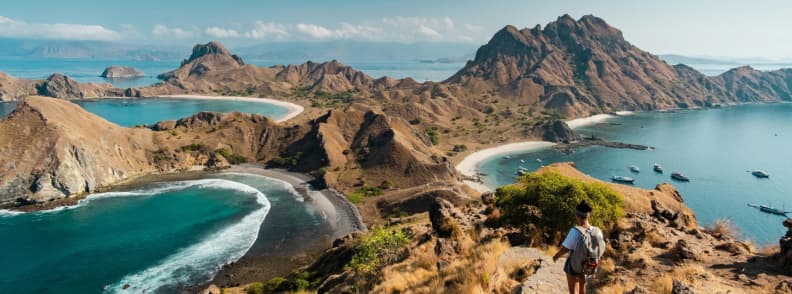
Choose The Right Tour Operator
With so many tour operators running trips from Labuan Bajo, it’s tempting to go for the cheapest option, but be cautious. Low-cost, high-volume tours often cut corners: overfishing for guest meals, overcrowding boats, or feeding Komodo dragons (which is not only dangerous but illegal).
Look for Komodo tour companies that:
- Limit group sizes
- Follow park regulations strictly
- Provide local guides from nearby villages
- Use eco-friendly boats and supplies.
Ask questions before booking. A responsible operator will be happy to explain their practices, and may even offer slower, more meaningful trips, such as multi-day liveaboard tours that allow more time to explore lesser-visited areas.
Starting in 2025, some tour operators in Labuan Bajo introduced hybrid-electric boats after signing a green tourism agreement with the local government. The new boats run much quieter and use far less fuel (cutting emissions by more than half), which makes them better for the environment and a lot more pleasant for travelers out on the water.
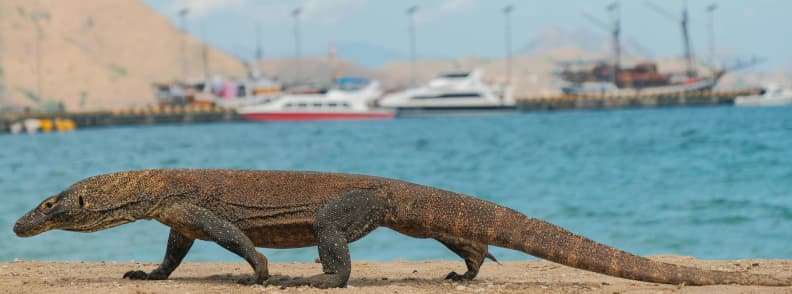
Understand The Rules Around Komodo Dragons
Komodo dragons are wild, powerful animals, not zoo attractions. You’ll always need to be accompanied by a Komodo National Park ranger when visiting their habitats, especially on Komodo Island and Rinca. Stay on marked trails, don’t approach the dragons, and never offer them food.
And if you’re lucky enough to see one up close, keep your distance. They may appear slow, but they can move surprisingly fast, and their bite is both venomous and dangerous. Your respect for their space is the key to both your safety and their well-being.
Recent reports show that the Komodo dragon population has stayed fairly steady since 2023, with roughly 3,300 dragons across the park. At the same time, rising sea levels from climate change are starting to shrink their nesting beaches. This makes it even more important for visitors to follow park rules, as rangers work to protect these vulnerable areas.
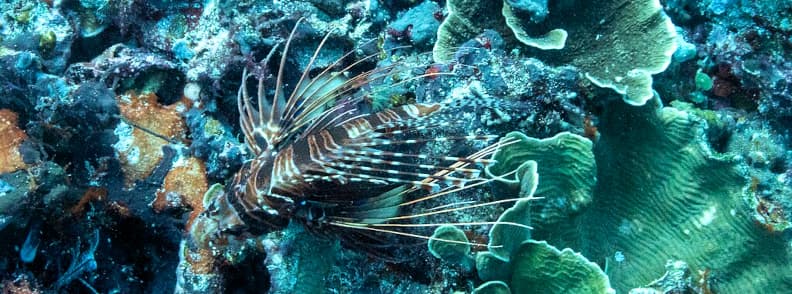
Dive And Snorkel Sustainably
Komodo National Park is part of the Coral Triangle, one of the most biodiverse marine ecosystems in the world. Divers and snorkelers flock here for manta rays, reef sharks, and colorful coral gardens. But those same reefs are fragile and easily damaged.
If you’re heading into the water, make sure:
- Your operator follows “no-touch” dive policies
- You wear reef-safe sunscreen
- You don’t stand or walk on coral
- You don’t feed fish or marine life.
Whether you’re diving at Manta Point, snorkeling in Taka Makassar, or swimming with turtles, leave nothing behind and take only memories (and photos).
In April 2025, Komodo became part of a UNESCO-backed coral reef resilience program, supporting restoration projects at Taka Makassar and Batu Bolong. Local dive shops are now working with marine scientists to plant heat-resistant coral fragments, helping to safeguard the reefs against future bleaching.
Don’t Forget The Basics
If Komodo is part of a longer trip through Indonesia, make sure your documents are in order. Depending on your nationality, you may require a tourist visa before arrival.
Planning makes your travel experience smoother and helps avoid unintentional overstays, which can result in fines or restrictions on future visits. That is why, before planning your Indonesian trip, you should check out professional websites to get the right info about visas and more.
Editor’s Note updated on 30 October 2025: Link to indonesiavisaonline[dot]com removed due to overdue payment after contracting content placement services via Businesssole[dot]com aka Ads Projects Group Ltd , GB362012933, 12844857 AND via Nikki Jain, Founder and CEO of The Sprout PR (who also mentioned redtulipmedia[dot]com for partial payment, which I refused). Invoice issued first on 3 October, payment was due by 8 October 2025.
By mid-2024, Indonesia had expanded its electronic visa-on-arrival (e-VOA) system to include more than 90 nationalities. Travelers can now apply online before their flights, which helps cut down long lines at airports like Denpasar and Labuan Bajo. At the same time, the government has been stricter about overstays, making it important to keep a close eye on your visa dates.
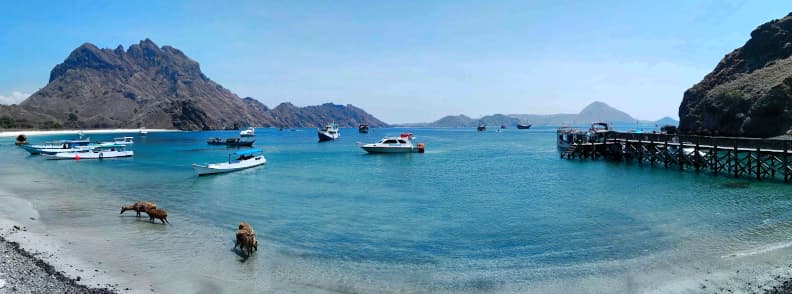
Give Back To The Community
The Komodo region is home to Indigenous communities who have lived alongside the dragons for centuries. Many now rely on tourism for their livelihoods, but not all tourism benefits are equal. When you spend money, try to direct it where it matters:
- Stay in locally owned guesthouses instead of big resorts
- Buy souvenirs made by artisans from the islands
- Eat at family-run warungs instead of imported franchise cafés
- Tip your guides and boat crews fairly.
Between 2024 and 2025, community-based tourism has grown in villages like Kampung Komodo and Warloka. Visitors can now stay in local homestays, join cultural workshops, and take guided mangrove tours. These experiences give travelers a richer look at daily life while making sure the money they spend goes directly to local families instead of outside investors.
Responsible travel is as much about respecting the locals as it is about protecting nature.
Komodo National Park Travel Tips for a Responsible Trip
Komodo National Park is a living ecosystem, a cultural heritage site, and a reminder that true adventure doesn’t have to come at the planet’s expense. By traveling slowly, making thoughtful choices, and showing respect for the dragons, the reefs, and the people, you’ll leave Komodo Park with more than just great photos. You’ll leave it better than you found it.
Looking ahead, conservationists say that finding the right balance between tourism and preservation will continue to be Komodo’s biggest challenge. At the same time, increased collaboration among local communities, eco-minded travelers, and the Indonesian government shows that sustainable tourism is a goal that’s already becoming a reality.
About the Author

I’m Mirela Letailleur, a Romanian travel blogger based on the Côte d’Azur who writes practical guides for cultural travelers and slow adventurers. I’m passionate about eco-responsible travel and helping readers make thoughtful choices that respect both nature and local communities.
On The Travel Bunny, I share detailed travel tips, from budget-friendly itineraries to advice on exploring protected places like Komodo National Park responsibly. My goal is to inspire smarter trips that protect fragile ecosystems while still creating meaningful experiences for travelers who want to move at a slower, more sustainable pace.
After reading my Komodo Island guide, check out these Indonesia travel articles
Spice Islands Indonesia: A Compact Guide for Explorers
Island of Lombok: Explore 7 Best Activities with Our Complete Guide

